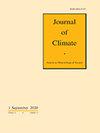Combined Impacts of Southern Annular Mode and Zonal Wave Three on Antarctic Sea Ice Variability
IF 4
2区 地球科学
Q1 METEOROLOGY & ATMOSPHERIC SCIENCES
引用次数: 0
Abstract
Abstract Large-scale modes of atmospheric variability in the southern mid-latitudes can influence Antarctic sea ice concentrations (SIC) via diverse processes. For instance, variability in both the Southern Annular Mode (SAM) and Zonal Wave Three (ZW3) have been linked to the abrupt 2015/16 sea ice decline. While SIC responses to each of SAM and ZW3 have been examined previously, their interaction and synchronous impact on Antarctic sea ice has not. Here, we investigate SAM/ZW3 interactions and their associated combined impacts on Antarctic sea ice using a 1,200-year simulation from a state-of-the-art climate model. Our results suggest that zonal wind anomalies associated with SAM drive SIC anomalies in the marginal ice-zone via advection of ice normal to the ice-edge and Ekman drift. In contrast, meridional wind anomalies associated with ZW3 can have opposing dynamic and thermodynamic effects on SIC. Both SAM- and ZW3-related SIC anomalies propagate eastward, likely by the Antarctic Circumpolar Current. The interaction of SAM and ZW3 leads to interesting regional SIC responses. During negative SAM, ZW3-associated meridional wind anomalies across western Antarctica are closer to the ice-edge and have a stronger impact on sea ice overall. ZW3 phase affects meridional wind anomalies across the whole ice-edge, whereas it affects SIC anomalies mainly over western Antarctica. In parts of eastern Antarctica, SIC anomalies are less sensitive to ZW3 phase, but are sensitive to SAM, particularly in locations where the ice-edge has a prominent angle relative to the SAM-related zonal wind anomalies.南环流模式和 "日冕波三 "对南极海冰变化的综合影响
摘要 南半球中纬度地区的大尺度大气变率模式可通过各种过程影响南极海冰浓度(SIC)。例如,南部环状模式(SAM)和第三带状波(ZW3)的变化与 2015/16 年海冰的突然减少有关。虽然之前已经研究了南极海冰对 SAM 和 ZW3 的响应,但还没有研究它们之间的相互作用以及对南极海冰的同步影响。在此,我们利用最先进的气候模式进行了 1200 年模拟,研究了 SAM/ZW3 的相互作用及其对南极海冰的相关综合影响。我们的研究结果表明,与 SAM 相关的带状风异常通过冰缘法线冰的平流和 Ekman 漂移驱动边缘冰区的 SIC 异常。与此相反,与 ZW3 相关的经向风异常会对 SIC 产生相反的动态和热力学效应。与 SAM 和 ZW3 相关的 SIC 异常都向东传播,可能是通过南极环极洋流传播。SAM 和 ZW3 的相互作用导致了有趣的区域 SIC 反应。在负SAM期间,南极洲西部与ZW3相关的经向风异常更接近冰缘,对海冰的整体影响更大。ZW3 阶段影响整个冰缘的经向风异常,而它主要影响南极洲西部的 SIC 异常。在南极洲东部的部分地区,SIC 异常值对 ZW3 相位的敏感度较低,但对 SAM 很敏感,特别是在冰缘与 SAM 相关的带风异常值有明显夹角的地方。
本文章由计算机程序翻译,如有差异,请以英文原文为准。
求助全文
约1分钟内获得全文
求助全文
来源期刊

Journal of Climate
地学-气象与大气科学
CiteScore
9.30
自引率
14.30%
发文量
490
审稿时长
7.5 months
期刊介绍:
The Journal of Climate (JCLI) (ISSN: 0894-8755; eISSN: 1520-0442) publishes research that advances basic understanding of the dynamics and physics of the climate system on large spatial scales, including variability of the atmosphere, oceans, land surface, and cryosphere; past, present, and projected future changes in the climate system; and climate simulation and prediction.
 求助内容:
求助内容: 应助结果提醒方式:
应助结果提醒方式:


